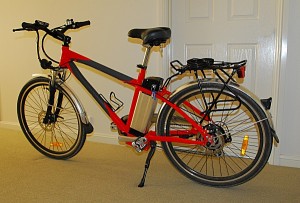A Bike with Electric Power
For these two days, I have an electric bike on test. The ‘test’ is ostensibly for me alone; a local dealer of electric bikes was offering a no-strings electric bike for a two day loan (“just give us plenty of feedback”) and I eagerly took up their offer.
The AUD$1399 bike is a Chinese-manufactured, purpose-built electric machine with seven Shimano derailleur gears, a 250 watt rear hub brushless motor, and a removable lithium-ion battery. The bike has a real-world range of well over 50 kilometres, the battery weighs about 5kg and takes five hours to recharge, and the control system allows twist-grip power-on-demand or you can set three different levels of assistance that kicks in whenever you pedal.
The electric system is quite effective but the bike itself is not so good. The front suspension forks offer plenty of stiction; I’ve seen them move only when subjected to at least 1g bumps. The wheelbase is long, the castor quite great – but, oddly, on loose surfaces you can easily provoke steering shimmy. The mechanical disc brakes growl and screech and grate, and I found the riding position rather uncomfortable. On the other hand, the carrier is well designed (it will take panniers without modification) and there are effective mudguards.
So what is the electric bike like in performance?
Firstly, the effect of the 250 watts is uncanny – compared to old fashioned electric bikes, the power is much stronger. I assume that’s because the hub motor has no losses in transmitting the torque to the tyre, but it may be that the power is actually greater than the stated figure. Set on Low, the power is obvious. On Medium the power is sufficient to propel you at 20 km/h, and on High the speed on the flat and without a headwind is 30 km/h. This is all with gentle pedalling – but rather than use this control, you can choose to not pedal and instead use the hand throttle (although I found this curiously unfulfilling).
My initial ride was out on a long country road, one that is largely flat but pocketed with small, sharp hills. It’s no use comparing the electric bike with and without the motor running – at 25kg, the electric bike outweighs any non-electric equivalent and so the comparison isn’t valid. Instead, you need to consider what another bike is like on this route.
Compared with the two pedal machines I’ve often ridden on this road (a Brompton folding bike and a self-built recumbent suspension trike) the electric machine was 50 to 100 percent faster – averaging a speed of something like 28 km/h. That was with my normal pedalling effort – the scenery simply flew past.
And up those short, steep hills? The electric bike was an amazingly three times as fast as my other machines, just rocketing up the hills with “where’s that hill?” nonchalance.
But after riding the bike for a few days, I didn’t want it. I ride for recreation, and so the pedalling effort is part of the enjoyment I get. Take that away, and a bike isn’t really a bike. However, for elderly people, or for those who do a daily commute (perhaps including some steep hills), an electric bike could both make the trip faster and allow it to be much longer.
Now, I wonder what this electric system would be like on a really good bike, or even a recumbent trike?

 Julian Edgar, 50, has been writing about car modification and automotive technology for nearly 25 years. He has owned cars with two, three, four, five, six and eight cylinders; single turbo, twin turbo, supercharged, diesel and hybrid electric drivelines. He lists his transport interests as turbocharging, aerodynamics, suspension design and human-powered vehicles.
Julian Edgar, 50, has been writing about car modification and automotive technology for nearly 25 years. He has owned cars with two, three, four, five, six and eight cylinders; single turbo, twin turbo, supercharged, diesel and hybrid electric drivelines. He lists his transport interests as turbocharging, aerodynamics, suspension design and human-powered vehicles.

